by Kristen | Apr 25, 2014 | garden food, Little Bytes

photo Boyd Hagen
Last week we talked about cut-and-come-again lettuces. We want to pass along a great article from www.vegetablegardener.com. THIS article is excellently written and has great information regarding cut-and-come-again lettuce including types and the author’s favorites. Enjoy!
by Kristen | Apr 25, 2014 | garden food, Little Bytes

photo credit www.almanac.com
We know, we know, we’ve spent a fair amount of time lately talking about lettuce. Are we done yet? Not quite. We want to share a few helpful links about lettuce growing. You know, just in case you want more information or there is a question we haven’t answered yet and you are just dying to know.
First up is this wonderful article from the Old Farmer’s Almanac about growing lettuce. We’ve shared some information from the Almanac in previous posts and it proves to be a great source of info through and through. The article covers the subjects of planting, care, pests, harvest/storage, varieties and even recipes. If you try the Lettuce Soup let us know how that goes for you.
by Kristen | Apr 23, 2014 | Little Bytes
So this happened last week… By the time the snow stopped we had about 3/4 of an inch.
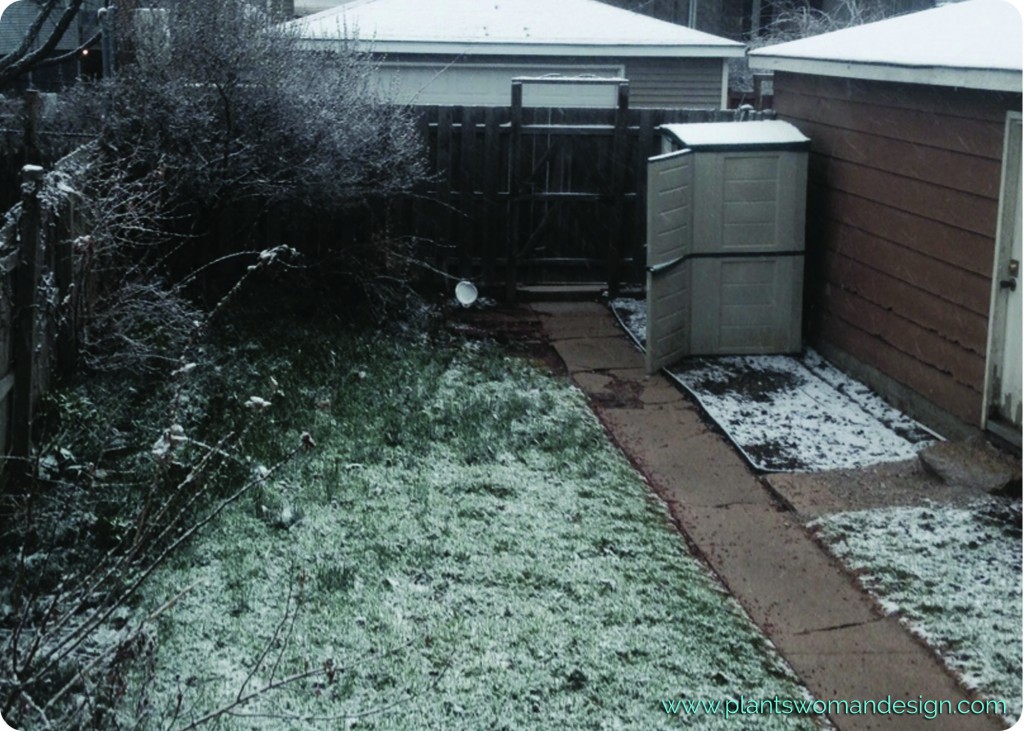
Since we are new to the Chicago area I’m in the habit of looking at the weather every morning, most of the time before I even get out of bed. The day I took this photo I looked at the overnight low and noticed it was saying 26.
Time to call my Plantswoman.
After I planted my herb container Susan and I talked about when to put my herb container outside. We estimated it should be okay to put them outside once the weather was reliably above freezing just to give the little guys a head start. I am in a zone 5B and the plants in my container should be hardy to 10 degrees. I put the planter outside about a week ago and the herbs wilted a little in protest. By the time our 70 degree day came over the weekend they were so happy. As I talked with Susan, over text, the forecast went from 26 to 24 and snowing. ARG! To be on the safe side we pulled the planter back to it’s inside perch in our (mostly) south facing window.
What was at stake here? Happier plants. We could have left them out there in the cold and snow but they wouldn’t have come out of it looking very appetizing. We are past the Almanac’s frost date but even then it’s 50% chance.
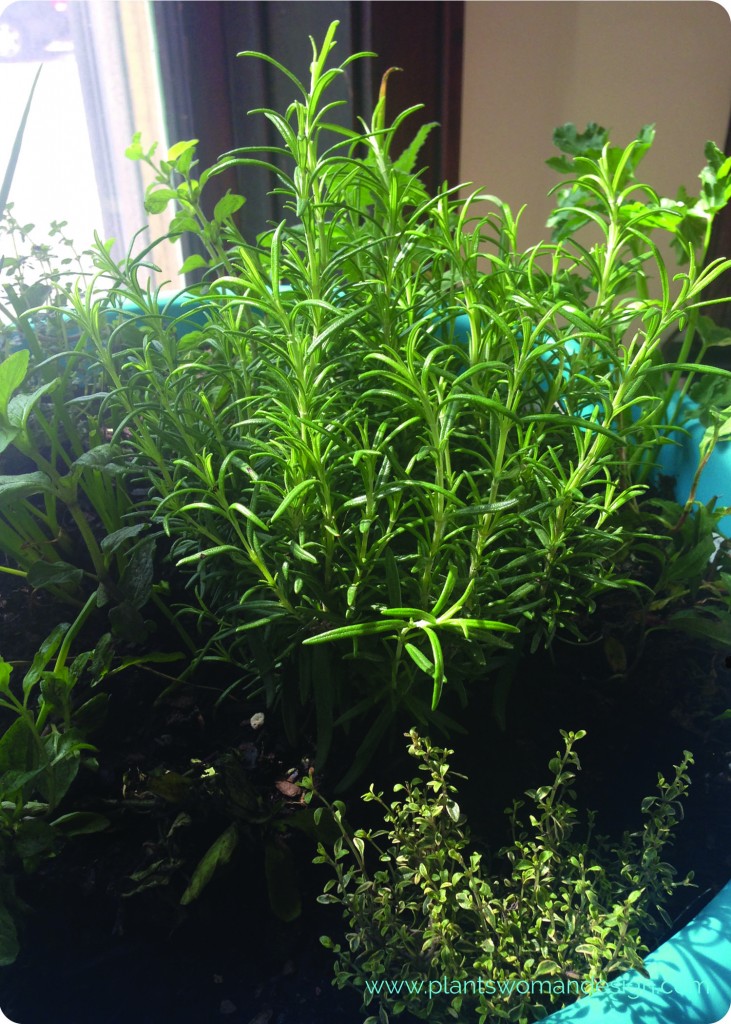
Let’s talk lessons learned…
- Check the weather. Just like your kids and pets, your plants may need an extra layer of protection here and there until the threat of frost and freezing temps are really, really over.
- Had the temperature not dipped so low we could have gotten away with lightly draping the container with a pillow case or light fabric.
Jen planted lettuce last week. Since I want to get a jump on getting my lettuce going too, I checked the Almanac to see when our last frost should be and they said April 20th. I’ll check one more time before planting though. Those containers are heavy and the thought of housing two of them inside won’t make me or those plants happy.
What are you planting, or getting ready, to plant?
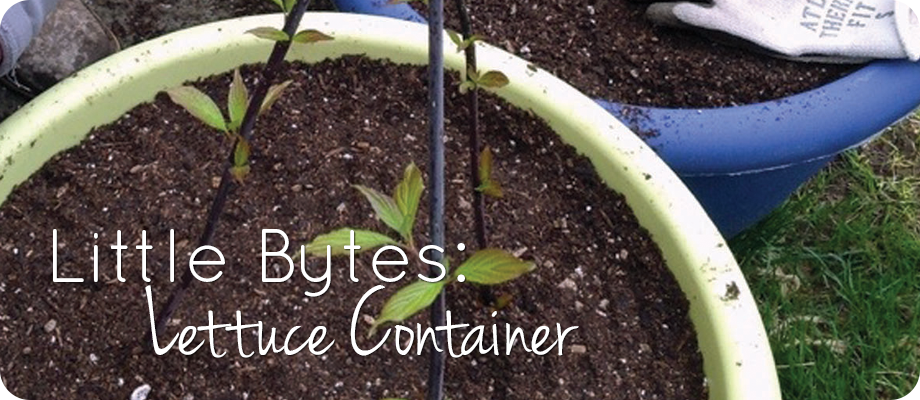
by Susan | Apr 18, 2014 | garden food, LB Tutorial: Growing Food, Little Bytes, Plantswoman Design
After last week’s post ‘Spring Yes, Spring’ it is time to get the lettuce in the containers. We are going to plant a mixed container with lettuce and spinach leaving room to plant green beans in just a few weeks.
*For more information about making your own lettuce mix check out this post from earlier this week.
As we talked about before lettuce is a cool weather crop. It germinates in low temperature and grows well early spring. You can keep growing it through the summer if you provide some cool shade. If the temps get too warm the lettuce and spinach will bolt. This means going to seed instead of just producing green leaves. I am in zone 7 here, which means my last frost date is usually April 15th. Check the chart at www.almanac.com to find your last frost date. The seed packets will also give the information on the back of the packet.
For this Little Byte we are going to use the Territorial Seed Company’s “City Garden Mix” seed pellets. These are great little inventions that have multiple seeds in a pellet form. The salad greens we are going to grow will be ‘cut and come again’. ‘Cut and come again’ means we will not spread the seeds out and grow the lettuce to a full head but instead cut the leaves as they are getting mature and harvest baby lettuce and spinach leaves. You see young lettuce and baby spinach both for sale. We are going to mix it with Catalina spinach.
Let’s get started!
First you need to prep your container, if you haven’t already done so. Take a look at this post to see how to prep your container. Before planting the lettuce seeds take a moment to install some supports. These supports will be for the climbing beans we will plant in a few weeks. We want to put the supports in now so we will be ready to go when it’s time to plant the beans. You can choose to go to your local garden center and buy a support structure or recycle some twigs or thin branches from your yard. Jen took a look around her yard and cut some 3 ft branches of black twig dogwood.
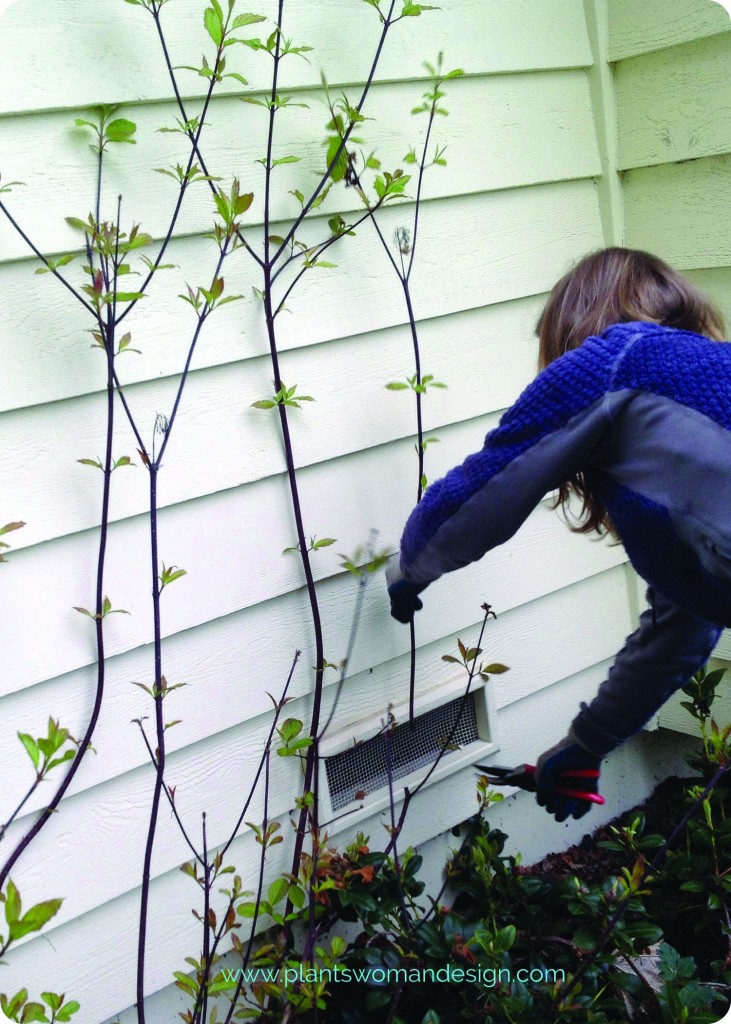
We will keep our eye on the black twig dogwood. They could root out because they are easy to start in water. Rooting out means they will send roots out and become new plants. We will see when we remove the beans after they are finished.
Set the twigs by pushing the supports into the soil creating a teepee like structure. When the beans grow up this structure it will create shad for the lettuce plants when the weather gets warmer. If you haven’t already, give your container a few taps and a good watering to help the soil settle. Firm down the soil around the container. You will want your final soil level to be about 2 inches from the top of the container.
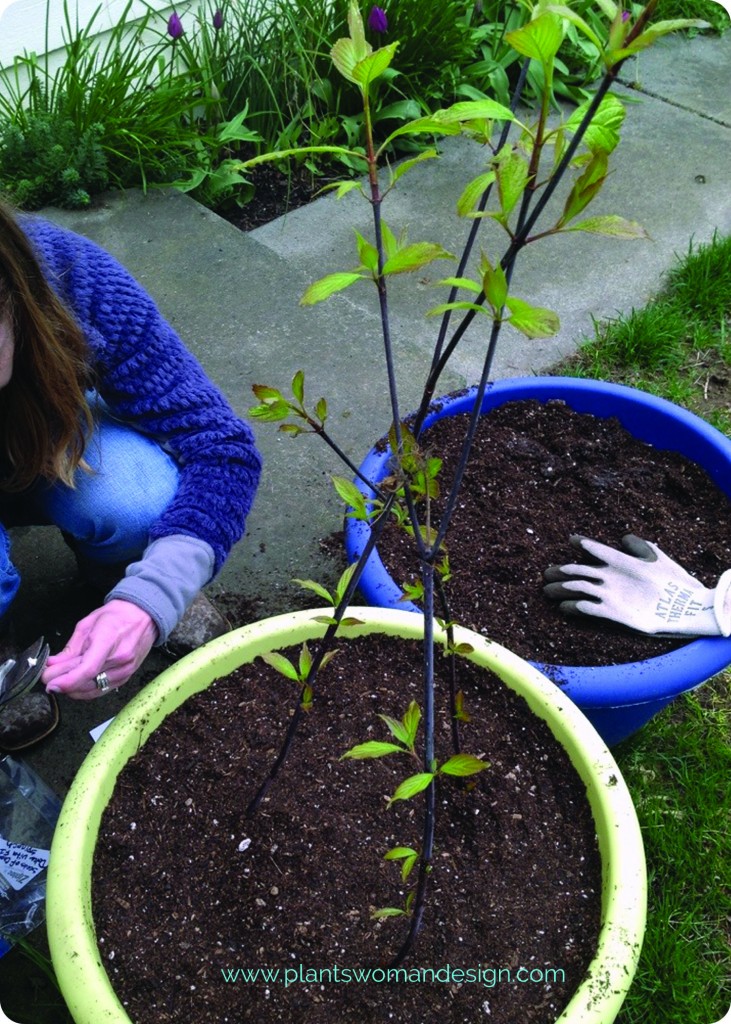
It’s time to put the seeds down. To plant our lettuce we aren’t going to dig the seed in but instead place the seed on top of the soil and spread some additional soil over the seed. These little salad greens just need 1/8 of an inch of soil over them so it is easier to just add the soil after you have laid the seed. If you already used all your soil just scrape some off the top of the container and set it aside. Place the seeds about 1/4 – 1/8 inch apart. Don’t worry about being too exact or about what the back of the seed packet says about spacing. We will harvest this before it reaches maturity so proper spacing for creating heads doesn’t matter as much.
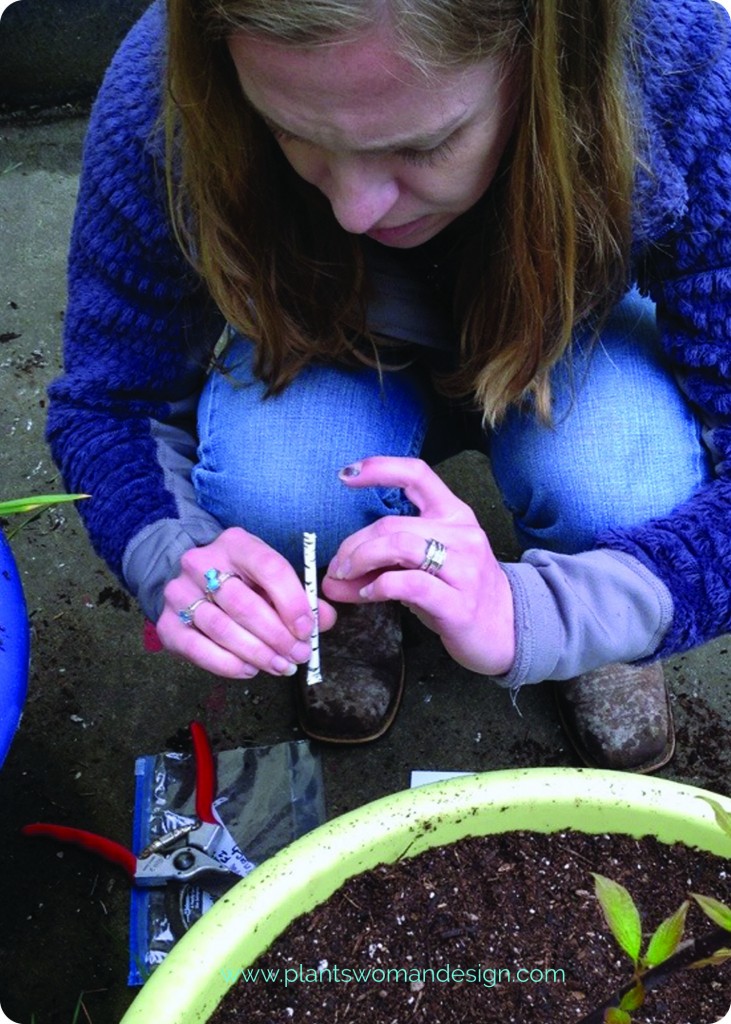
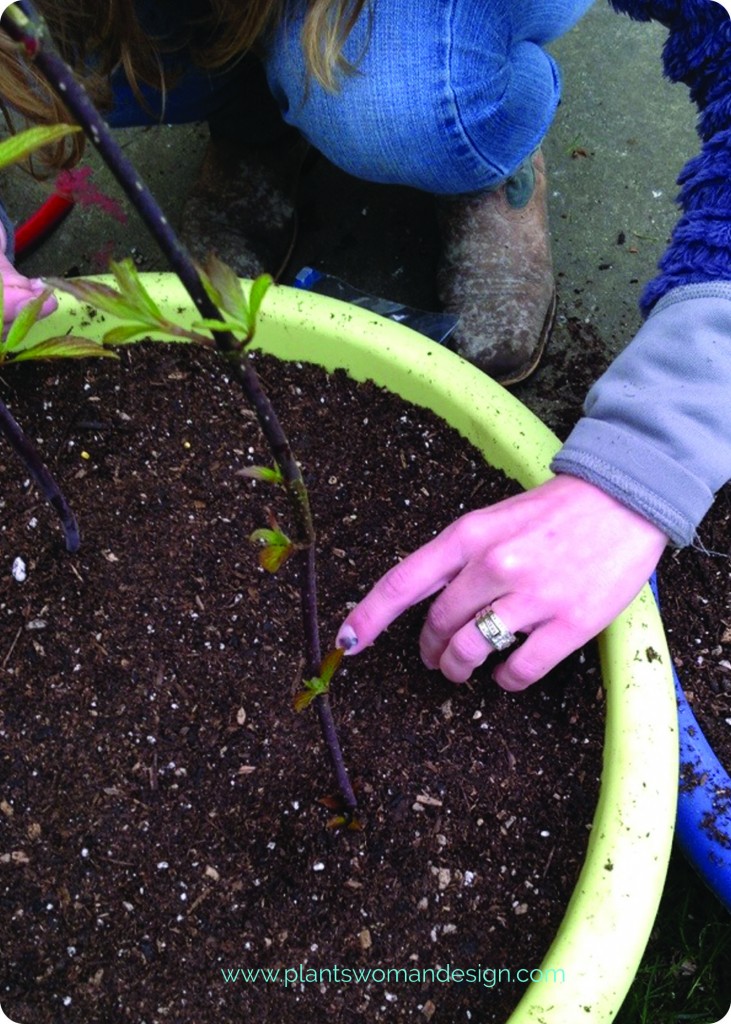
Once you’ve put all the seeds on the soil add the reserved soil lightly on top of the seeds. Press the soil down gently all around and water gently with a wand attachment if you have one. Be careful not to wash your seeds out of place.
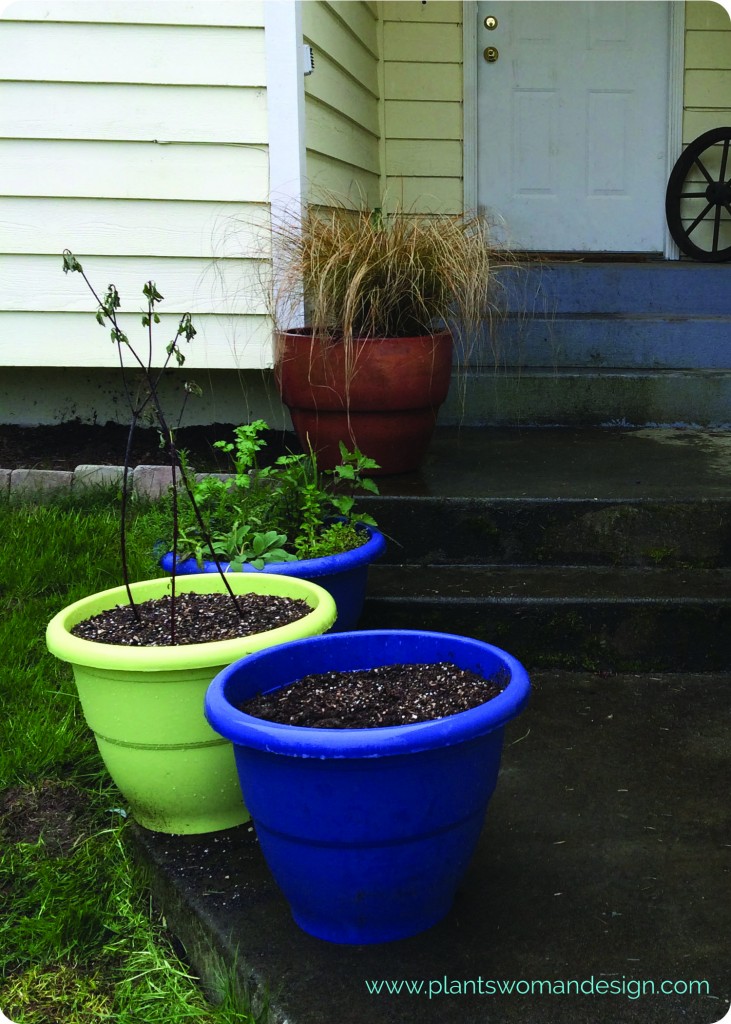
And you are done!
We should see germination of the lettuce in about 7-10 days if the weather remains “normal” for this time of year. Before leaving you newly planted pot swing by your herb container if you planted one with us. Jen visited her herb container and cut some chives for baked potatoes. She can already harvest some of the things she just planted! How great is that? Remember, if you use scissors to cut vegetables or herbs, make sure they are not rusty. A rusty knife or scissors can bring rust to the whole plant. I usually just pinch with my fingers.
I’m off to the green house to check on my tomato seeds… I’ll be sure to let you know if they are up yet.
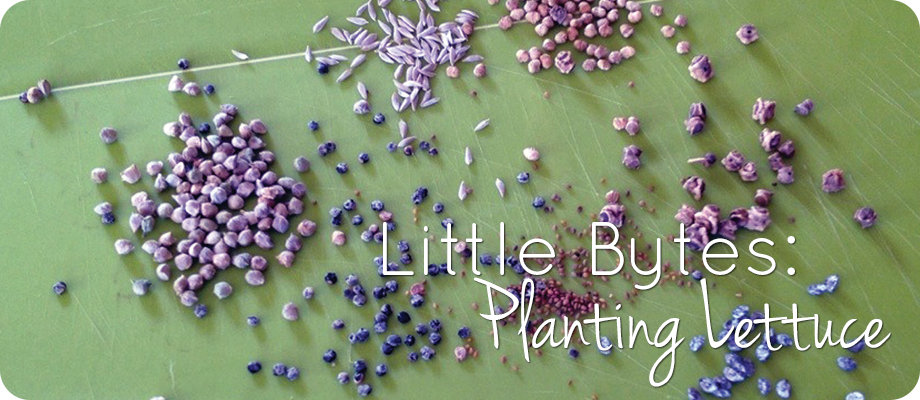
by Susan | Apr 16, 2014 | garden food, LB Tutorial: Growing Food, Little Bytes, Plantswoman Design
Its almost time. Earth is warming, sun is shinning and now I can stop pacing in front of the window and start planning, purchasing, and planting. Lettuce is one of the first things of the season you can plant. There are some fun ways to start planting with introductions of new lettuce blends and new ways to deliver the blends.
While visiting the nursery and looking for new lettuce seeds I was amazed at how many there were. Seems like that is the trend right now. Of course that started me to thinking why blend only lettuces together. When you go to the store there are all different blends for salad mixes. You will see spinach blended with baby romaine, baby beets, and lettuces, and so on. So I thought why not plant them together. They can all be growing about the same time with different rows, I typically cut my salad greens when they are young so don’t really worry about ‘maturity’ dates.
So off I go to do research. For our purposes we need to know germination rate (how long it takes the seed produce something green that we can see). We want all of our seed to germinate within a few days of each other. This means they will be ready to harvest in their ‘baby greens’ state about the same time. Most salad greens can be treated as ‘cut and come again’.
Strangely enough some seed packets don’t have very much information. I think all seed packets should give basic information and some uniformity would be great. One packet will say how to plant, spacing and harvest but not give a germination rate. A couple even gave recipes! The seed packet is pretty small so I’d rather see great information about the seed, as much as is available, instead of a recipe.
Some rules of gardening to keep in mind as you choose your mix.
1. Same temperature for germination. Don’t use warm weather crops with cool weather crops.
2. Same time of germination. You want seedlings to show up about the same time within a few days or a week.
3. Use good quality seed and no old seed. Many people know that seed can be saved over one season to the next. The seed will still come up but germination rates are decreased.
4. Planting depths should be about the same. 1/2 in to 1/4 inch choose the 1/4 inch depth for all. 1 inch to 1/4 inch choose another variety closer to the same.
I picked out some great seeds to mix up:
- Gala Mache- Lamb’s lettuce (European favorite) – Renee’s Garden Seeds
- Rustic arugula – an heirloom variety from Italy – Renee’s Garden Seeds
- Red and Golden beets – Cooks Garden Seeds
- Flashy Trout Back Lettuce , Heirloom Cutting Lettuce -Renee’s Garden Seeds
- Catalina Spinach Baby Leaf Spinach – Renee’s Garden Seeds
- Fire Red Orach, French Spinach – Ed Hume Seeds
- Sprint Salad Scallions, Green onions – Renee’s Garden Seeds
Side Note: The French Spinach is not a true spinach (interesting right?). It has purple leaves, very nutritious and can be harvested young or cooked like green spinach when it matures.
The scallions can be cut with the rest of the greens to add a mild onion flavor. Beet greens can be cut and harvested young too. We will only use part of the seed packets in the mix and use the rest in a separate row of the garden and allow them to mature into full heads of lettuce.
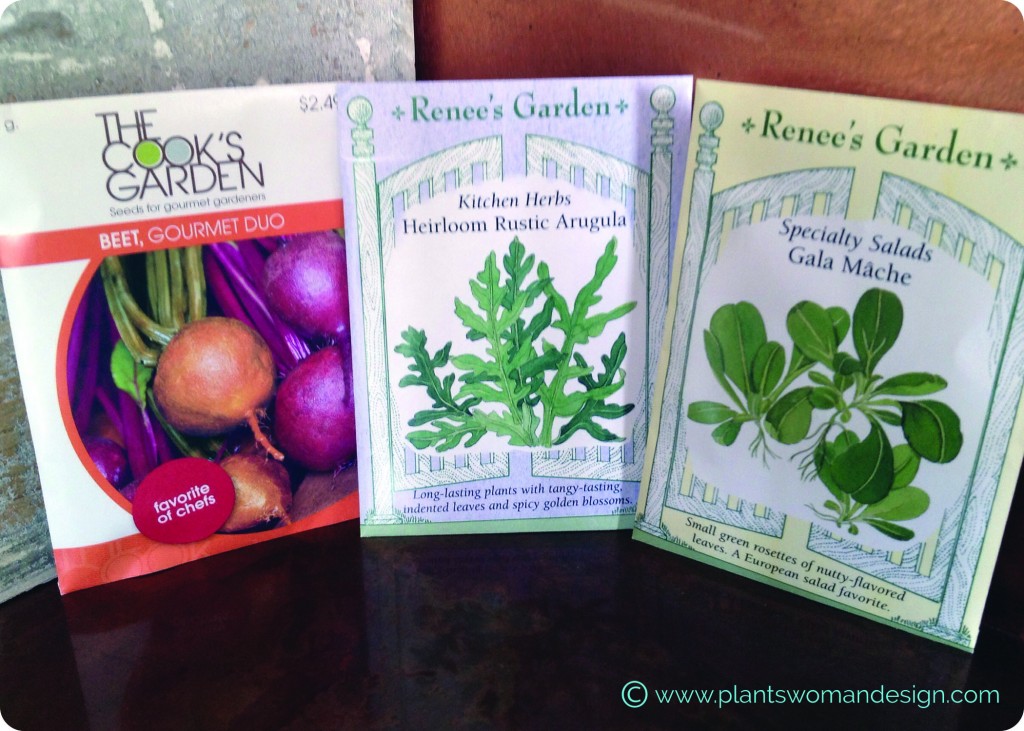
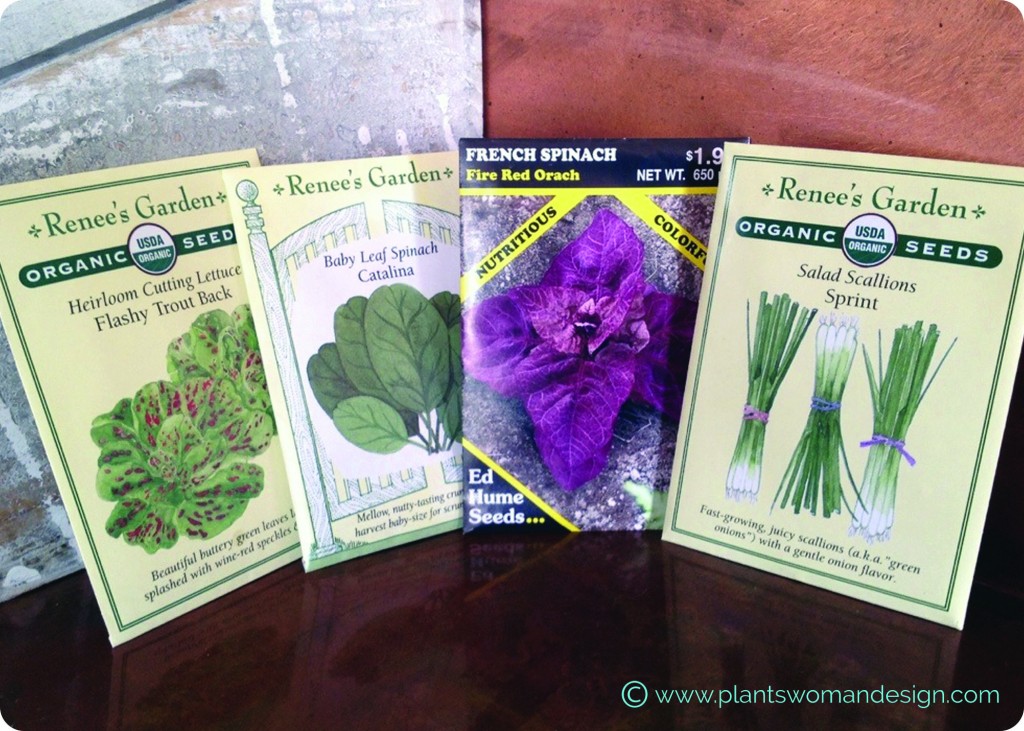
When I was ready to plant my crop I poured the seeds out together on a mat to mix. Then I funneled them back into the pack for spreading into my prepared soil.
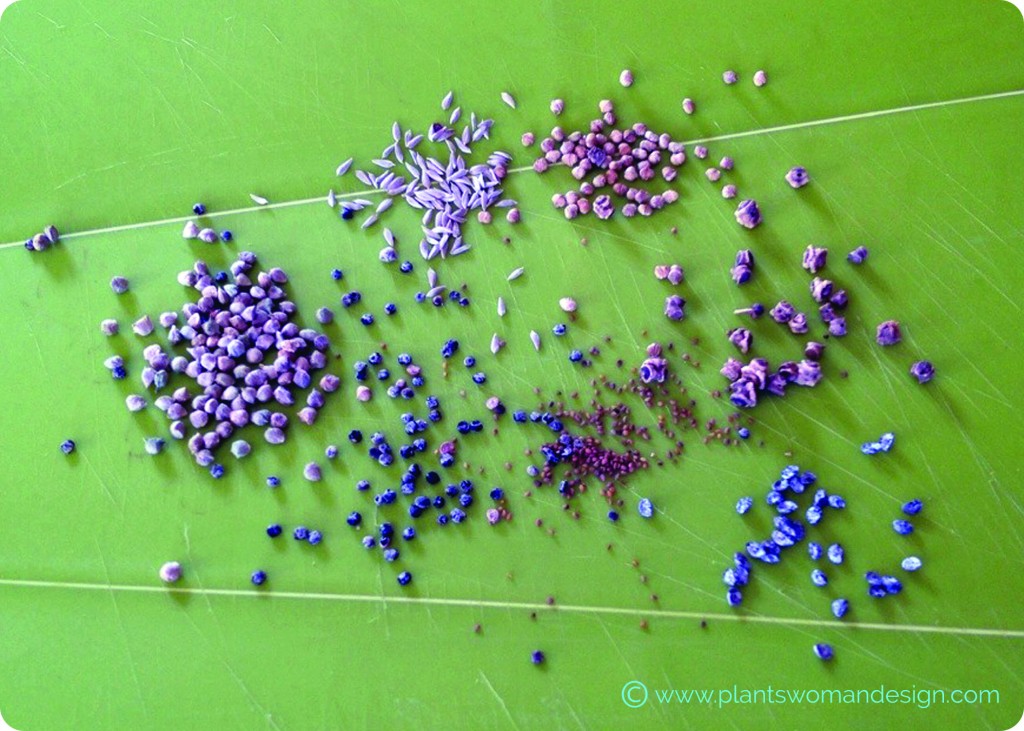 Today is March 23rd and I will go out and plant my seed mix. The earth feels fairly warm and is nice and crumbly, nice to work. I mixed them together into a seed envelope so they could be spread easily. I scattered thinly and then went back over the same line. The bigger heavier seed came out first and the smaller lighter seed came out after. The row is a little broader than my regular rows but I want to cut them in bigger sections so that will work.
Today is March 23rd and I will go out and plant my seed mix. The earth feels fairly warm and is nice and crumbly, nice to work. I mixed them together into a seed envelope so they could be spread easily. I scattered thinly and then went back over the same line. The bigger heavier seed came out first and the smaller lighter seed came out after. The row is a little broader than my regular rows but I want to cut them in bigger sections so that will work.
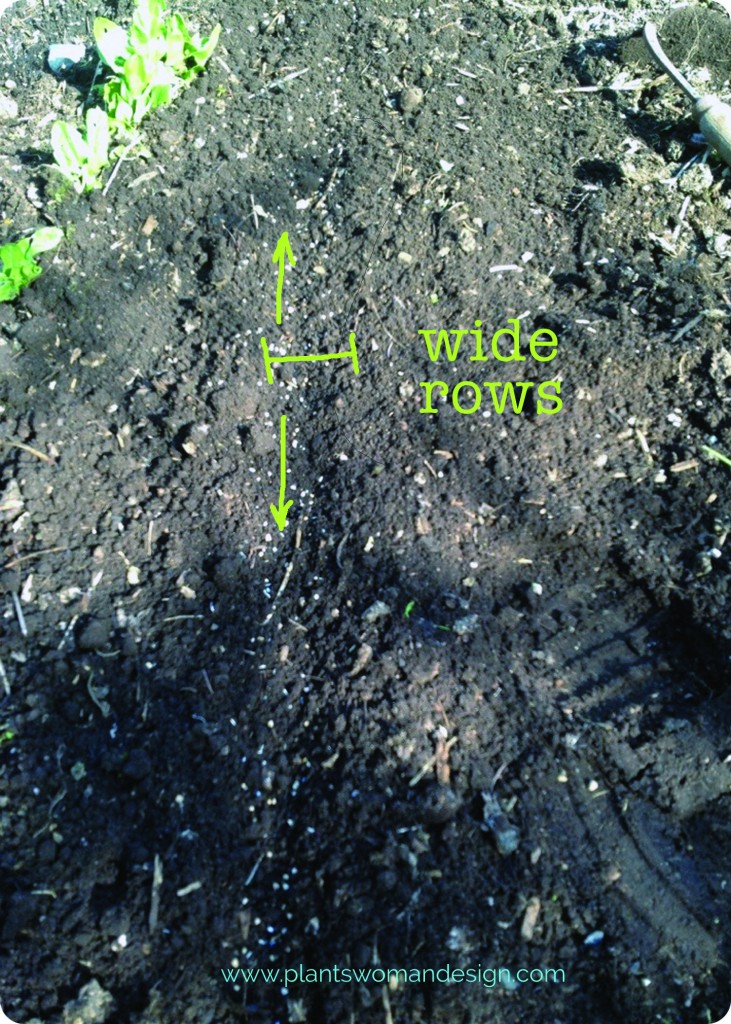 I watered the row in well and placed a grid of metal over the top. I will remove it when I start to see germination. It keeps the birds from going back into the newly tilled up space and eating the seeds. In some cases (the peas) I leave it in place the peas grow through it and it protects from rabbits and cats digging.
I watered the row in well and placed a grid of metal over the top. I will remove it when I start to see germination. It keeps the birds from going back into the newly tilled up space and eating the seeds. In some cases (the peas) I leave it in place the peas grow through it and it protects from rabbits and cats digging.
 Let’s talk about soil real quick… My soil had organic matter dug into it in the fall and is ready to plant now. I really spend a lot of my energy getting good viable soil that is strong and has lots of organic matter and worm action. This means I won’t have to do a lot of fertilizing later on. Everything we grow needs a good foundation of soil. This helps with pests and diseases because you have really healthy plants. I will fertilize with a diluted fertilizer only once in the season when the seedlings are about 1 inch tall.
Let’s talk about soil real quick… My soil had organic matter dug into it in the fall and is ready to plant now. I really spend a lot of my energy getting good viable soil that is strong and has lots of organic matter and worm action. This means I won’t have to do a lot of fertilizing later on. Everything we grow needs a good foundation of soil. This helps with pests and diseases because you have really healthy plants. I will fertilize with a diluted fertilizer only once in the season when the seedlings are about 1 inch tall.
I’ll keep you posted on how the seed mix is doing. Let me know if any of you try out a mix of your own…..
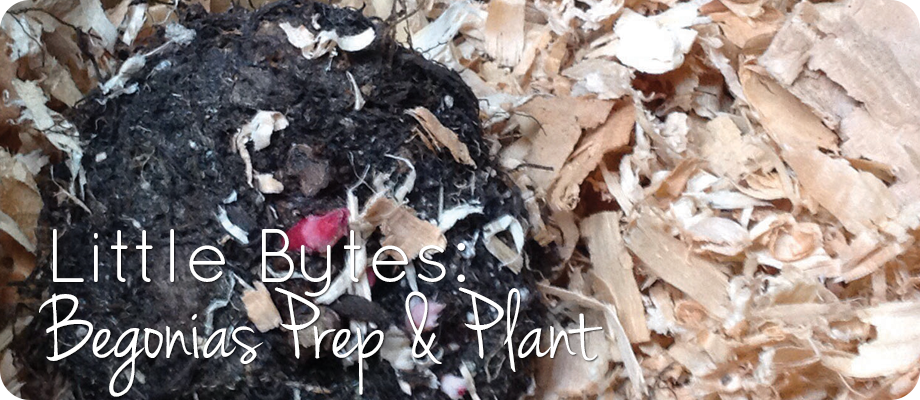
by Susan | Apr 4, 2014 | LB Tutorial: Bulbs & Tubers, Little Bytes, Plantswoman Design
If you have been following the blog for a while you will remember in fall we pulled our begonias out after the first frost and stored them over the winter. If you didn’t have any to winter over they are available at the Nursery now and you can grab a couple of tubers and follow along with us. It is time to bring them out of their little dark box and bring them into the light. We will give them a soft bed of soil and water and they will be on their way again. Let’s have a look at the box where we stored them.
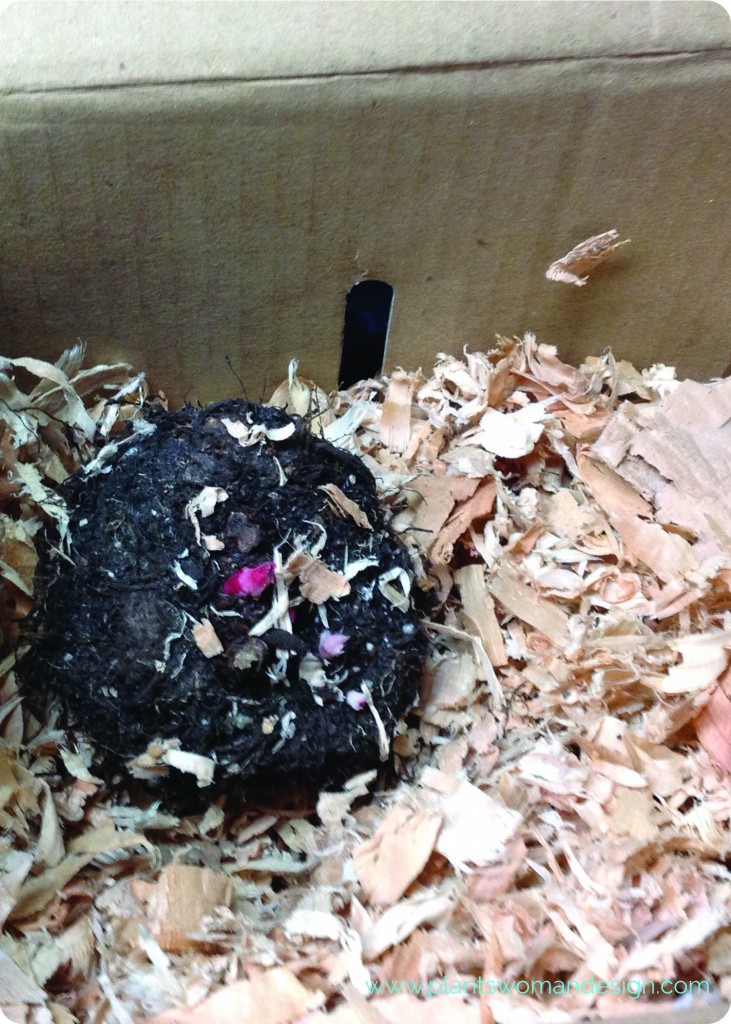 See the little growth points of pink? That is where the first leaves will come out and start their growth again. The tuber is solid and firm with no soft parts or mold (which is how it should be).
See the little growth points of pink? That is where the first leaves will come out and start their growth again. The tuber is solid and firm with no soft parts or mold (which is how it should be). I usually prepare a long tray with fresh seed starting soil mix. This shallow tray is perfect for waking your begonias up, then they will be transferred to the container you want them to live in through the summer. We will transfer them after they have put on some good growth and the weather is warmer. You could put them straight into the pot when it gets warmer but it will take longer to get going and longer to get flowers. As you can see from the little buds showing they are ready to go too.
I usually prepare a long tray with fresh seed starting soil mix. This shallow tray is perfect for waking your begonias up, then they will be transferred to the container you want them to live in through the summer. We will transfer them after they have put on some good growth and the weather is warmer. You could put them straight into the pot when it gets warmer but it will take longer to get going and longer to get flowers. As you can see from the little buds showing they are ready to go too.
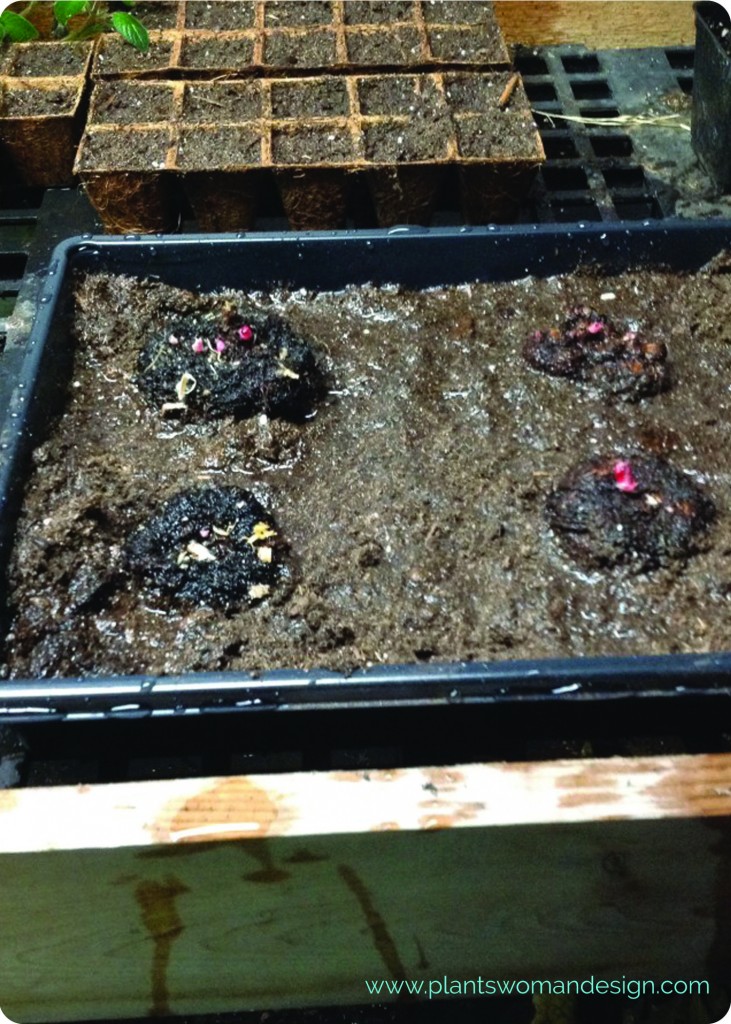
Let’s soak the soil through so there are no dry pockets. Then just set the tuber onto the soil and gently settle it down so the soil comes up about 1/2 way up the side. Now all you have to do is wait, water, wait, warm…. Maybe waiting is the hard part. It is one thing that gardeners have to learn that is very difficult. That’s it…… Really…. That’s it.
There is always a danger when going to the nursery just to buy a tray and seeding soil. Passing by other things that call to you and in this case it was a sweet little Hymenocallis.
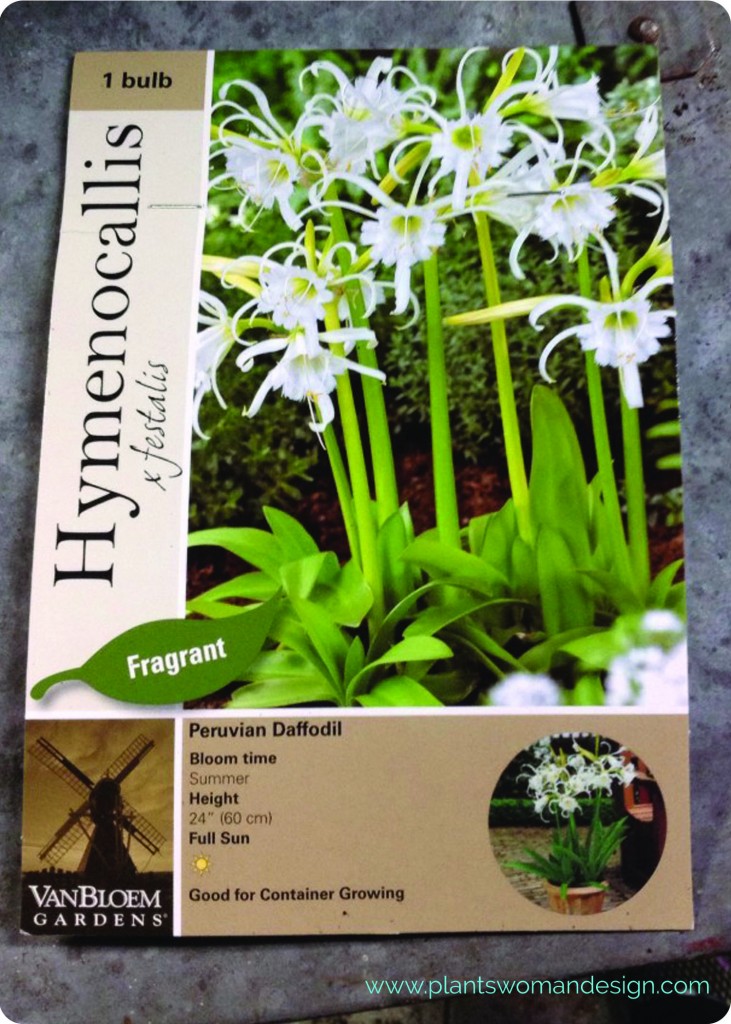
One of the funnest things about these is they can be put into a pot and brought out to brighten a spot in your home and bring in a little fragrance. This is super easy too. You can choose a similar flower or bulb. Look for a recommendation that it can be grown in a container. This will keep it easy. Just grab a pot that you like because this bulb will stay in it.
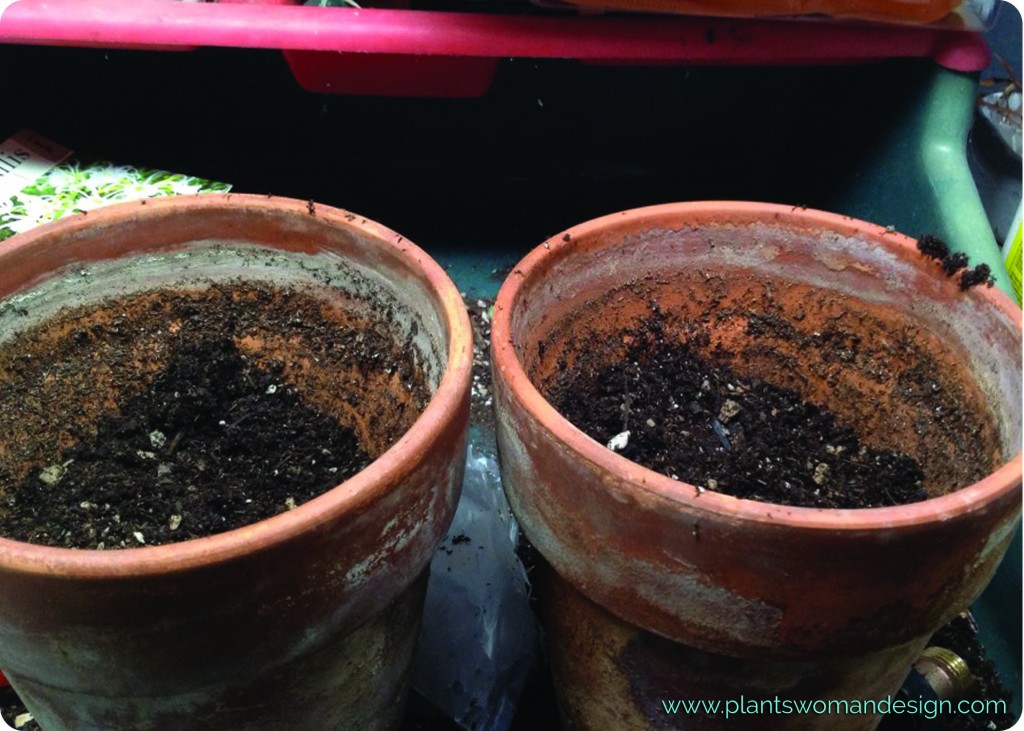 First put in enough soil to bring the bulb to the level on the back of the package. This is a fairly deep pot so there is enough room to do it. If you use a pot that is more shallow you may have to stake the bulb when it blooms. Just be sure there is at least 1/2 of the pot filled with soil before you plant the bulb. Sprinkle a little bulb food in the container and then put the bulb on top of it.
First put in enough soil to bring the bulb to the level on the back of the package. This is a fairly deep pot so there is enough room to do it. If you use a pot that is more shallow you may have to stake the bulb when it blooms. Just be sure there is at least 1/2 of the pot filled with soil before you plant the bulb. Sprinkle a little bulb food in the container and then put the bulb on top of it.
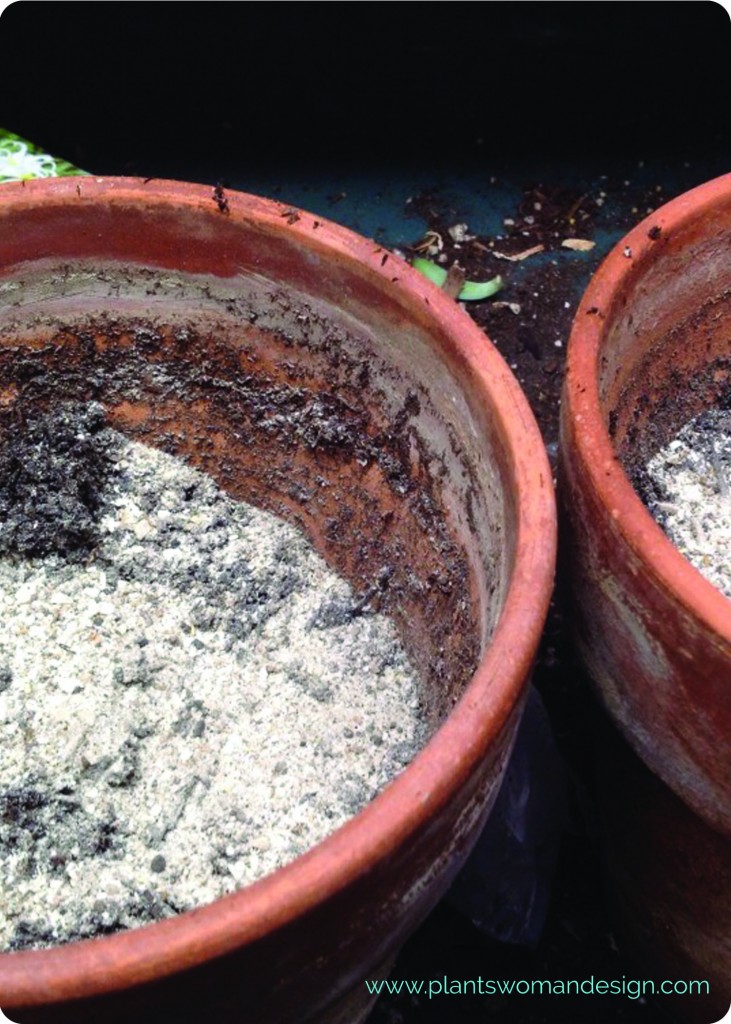
Drop the bulb into the soil gently spreading out any roots that are there.
Cover up the rest of the bulb with soil, water well, and …… wait.
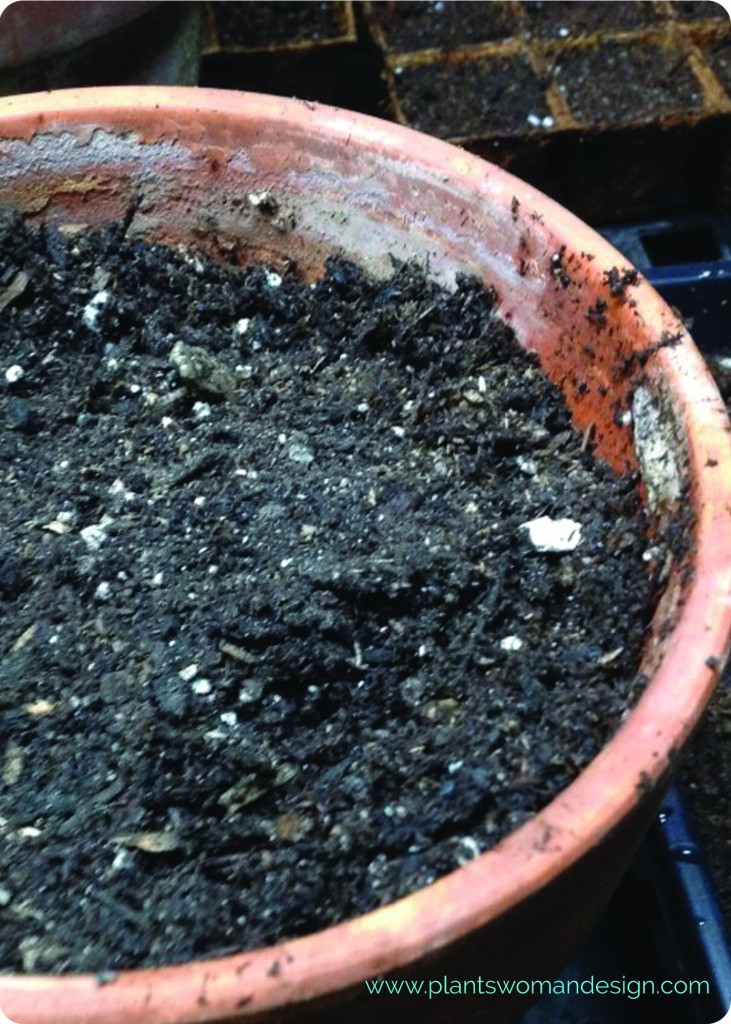 Remember you do not need a greenhouse to do these projects/experiments. Just a sunny window will do and they will be ready to transplant outside before they get very big.
Remember you do not need a greenhouse to do these projects/experiments. Just a sunny window will do and they will be ready to transplant outside before they get very big.
In these days of ‘instant’ there is something unusual about waiting. We don’t really wait for much. I really admire the people who grow from seeds. They are so patient. They have learned the art of waiting and the excitement of seeing a seed sprout and become a wonderful plant. I read recently about a couple who grew trees from seed and live to see them mature and then harvest them. Some had been growing for 40 years. I think that would be hard to do. I do encourage each of my followers to grown something from seed. We will do easy seeds next week (lettuce) and I will start tomatoes by seed indoors later in the season.
Remember to share your gardening exploits with us here on the blog or via Facebook, Instagram (#susan_PWD) and Twitter (@susan_PWD)!
by Kristen | Apr 2, 2014 | Little Bytes
Hello friends! Kristen here with an herb pot I successfully planted this past weekend using the Little Bytes tutorial we posted last week. This winter has been terribly cold and really long here in Chicago. I’ve heard that our spring is something like two weeks late. After a week of waking up to fresh snow we are so ready for spring to get here. Last night we had our first thunder storm of the season so I’m taking that as a sign that the end of winter is here.
We live in an apartment with a shared back yard and we love to cook. Buying fresh herbs can get expensive so planting our own herb container was high on our priority list of things to grow this year. When we started talking about planting an herb garden I went to buy supplies and the garden centers had NOTHING. The small amount of potting soil and compost they did have was still encased in ice and snow and completely frozen to the core. It took two of us to get the bags I needed out of the pile. I let the bags of soil and compost thaw out in the basement until I was ready to use it.
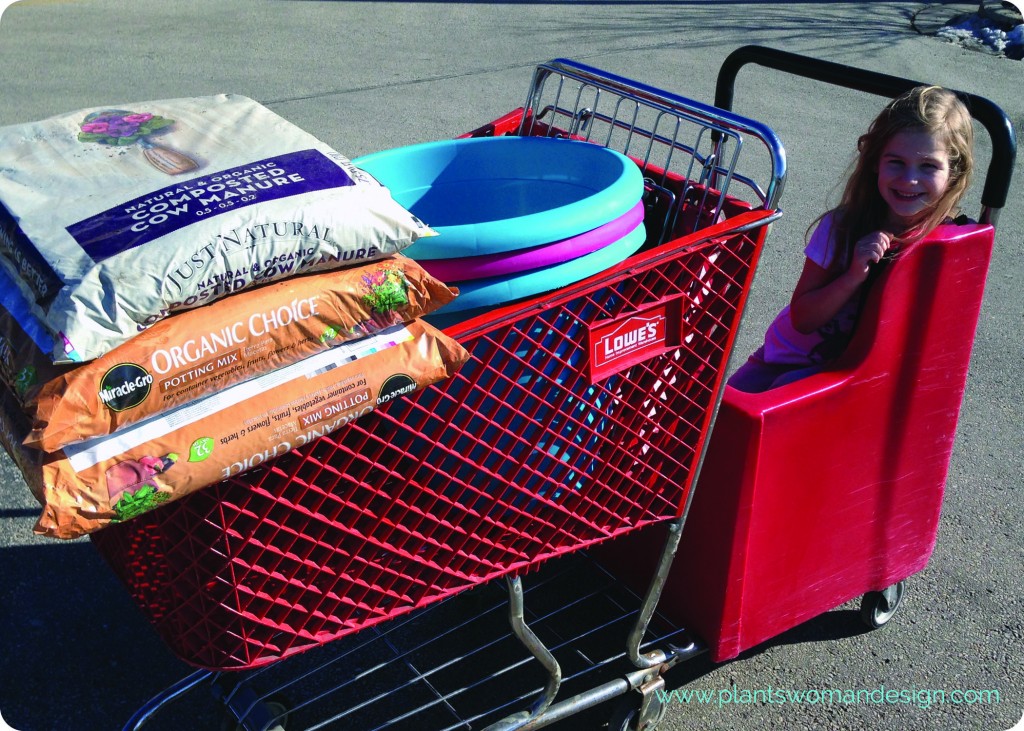 For comparison sake Jen and I have the same containers and plants. Since I am a little early in our season I just couldn’t find any plants at my local nurseries so, Jen and Mom sent me some plants to play with. When they got here they were a little sad but, not to worry, once they were nestled in their new soil they perked up and are just fine now. Before I started to plant I got all of my supplies together.
For comparison sake Jen and I have the same containers and plants. Since I am a little early in our season I just couldn’t find any plants at my local nurseries so, Jen and Mom sent me some plants to play with. When they got here they were a little sad but, not to worry, once they were nestled in their new soil they perked up and are just fine now. Before I started to plant I got all of my supplies together.
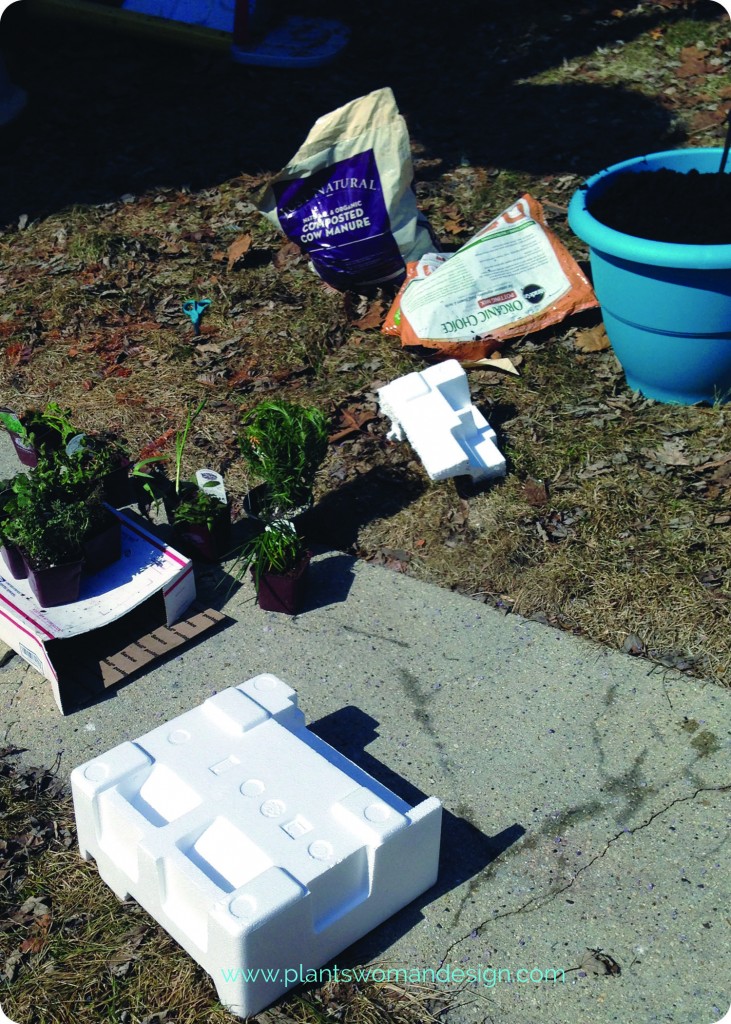
I noticed that I was lacking some important gardening implements… Like a small shovel or spade and gardening gloves. I made due with a large kitchen spoon this time around but I will be getting some tools before next go round.
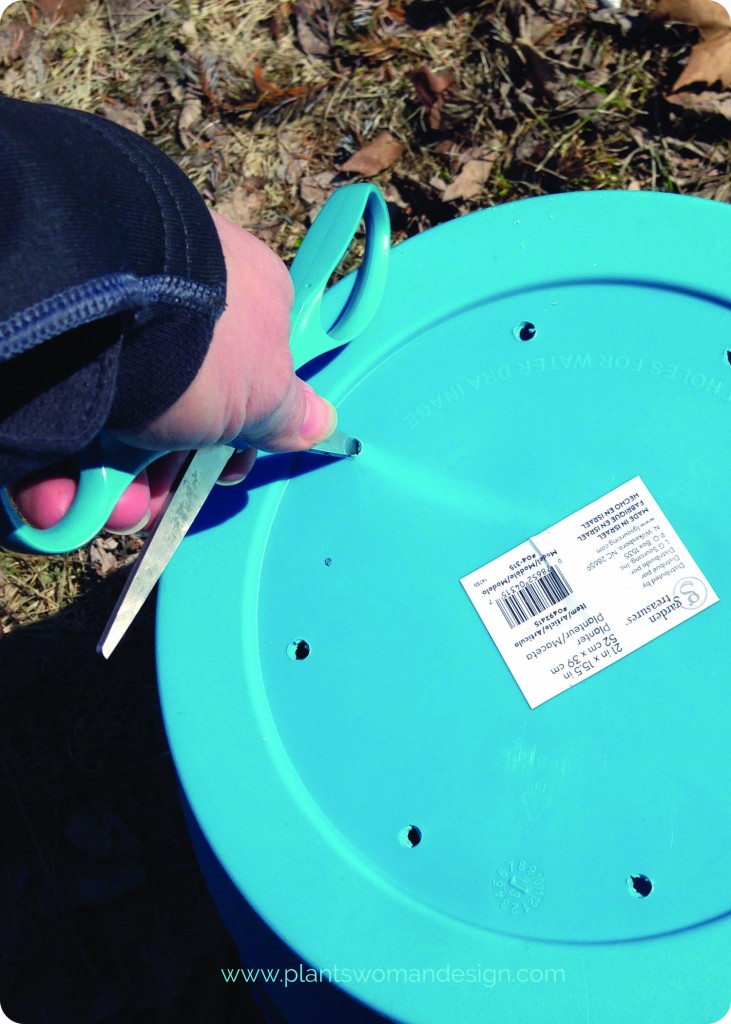
It looks like Jen had a hard time pushing the drainage holes through on her pots using bigger tools. Knowing that, I tried to sneak up on it and used a pair of scissors first. Perfect!
The tutorial calls for a filler of some sort. So, I “shopped the house” to see what I could find. I found the box from our Kureg machine on the porch that was recently freed from the snow and found some Styrofoam pieces inside that would work. I needed to break the larger pieces into pieces that would fit all the way to the bottom of my container so I scored the pieces with my scissors and then broke them over my knee like you would a stick. Some of them I just jumped on and that worked too. Because my filler pieces were so big I didn’t feel like I needed to place additional drainage helpers over the holes.
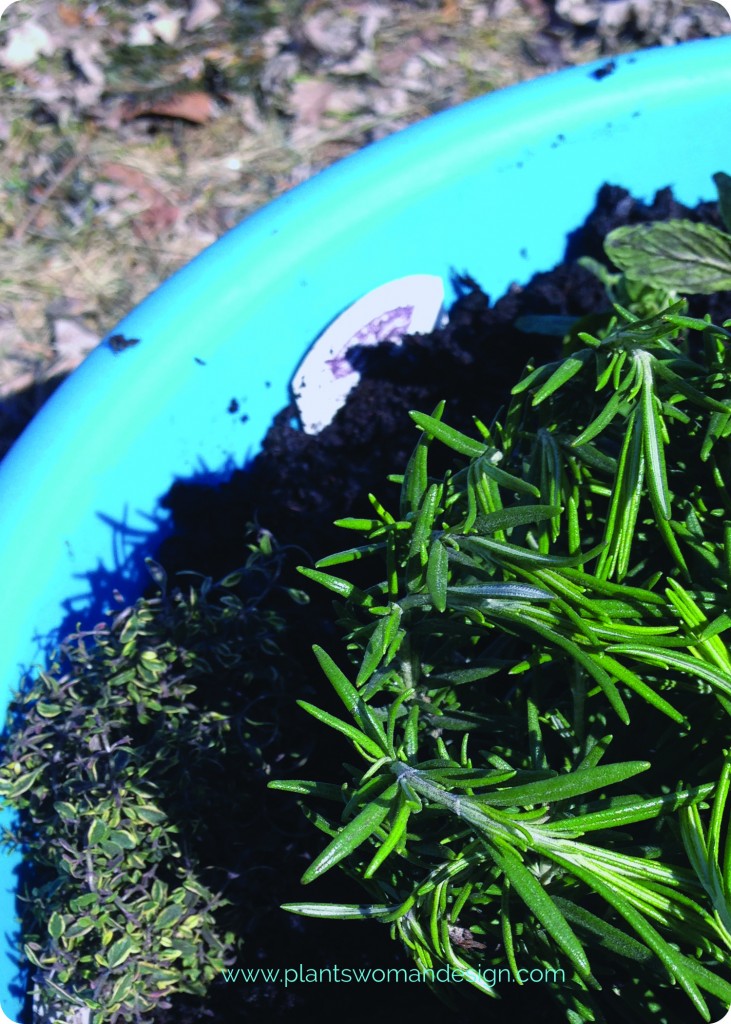 Planting went quick and easy. I tucked the plant tags along the perimeter of the container as close to the plant as possible. I’ve got very few extra brain cells available to remember plant names so having the tags close to hand is a must.
Planting went quick and easy. I tucked the plant tags along the perimeter of the container as close to the plant as possible. I’ve got very few extra brain cells available to remember plant names so having the tags close to hand is a must.
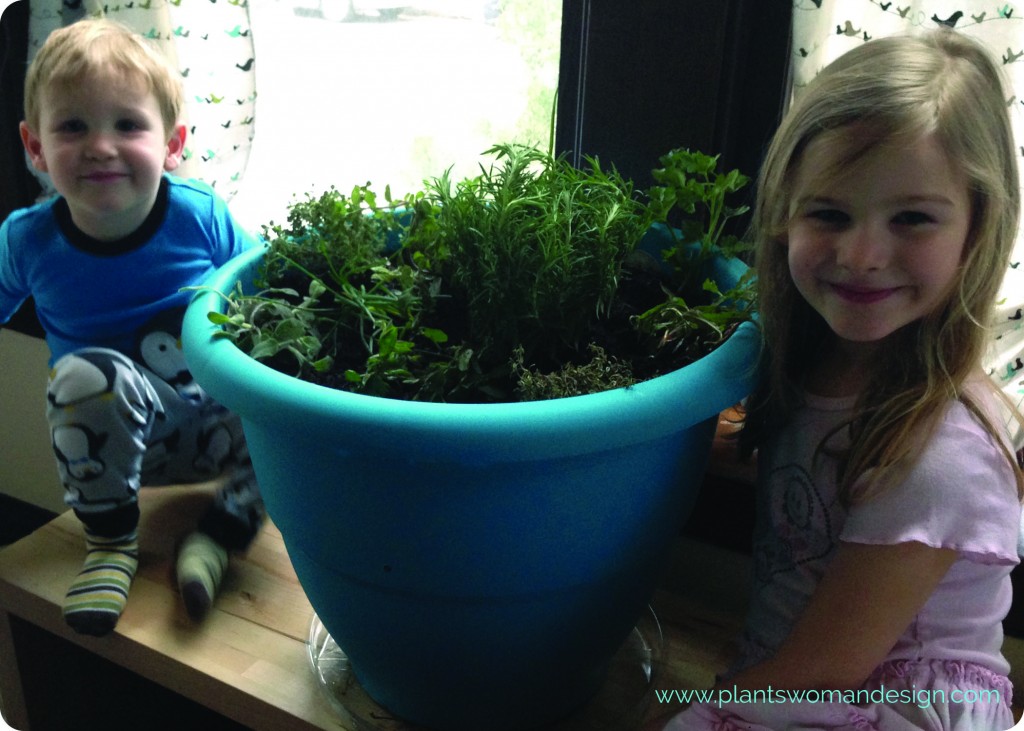 Though it was sunny the day I planted, the temp was only about 35. So, these lovelies get to hang out inside until the threat of freezing is over. I think they will get to go outside this week sometime. It’s been so nice to have a bit of green inside I may be in the market for additional indoor plants. I’m thinking some succulents or something like that. My mom has a wonderful collection of succulents that I just love every time I visit. I may steal that idea.
Though it was sunny the day I planted, the temp was only about 35. So, these lovelies get to hang out inside until the threat of freezing is over. I think they will get to go outside this week sometime. It’s been so nice to have a bit of green inside I may be in the market for additional indoor plants. I’m thinking some succulents or something like that. My mom has a wonderful collection of succulents that I just love every time I visit. I may steal that idea.
So, did you plant an herb pot this weekend too? Send us a picture! You can share it on our FaceBook page, tweet it to us on Twitter or email us at info[at]plantswomandesign[dot]com. We would love to see what you came up with!
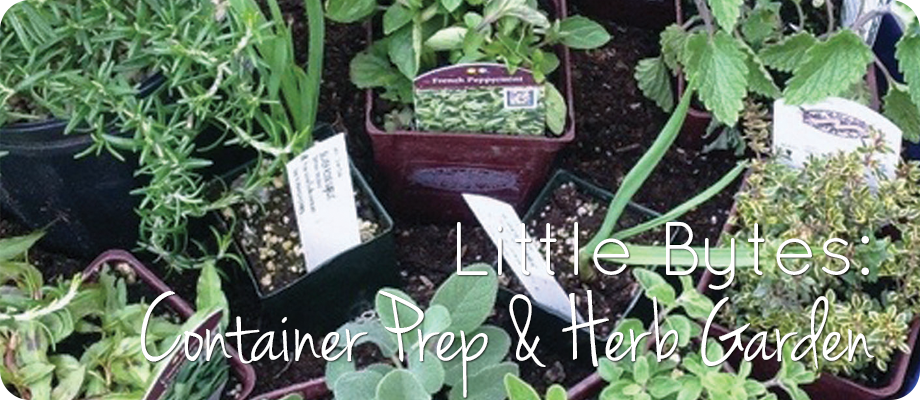
by Susan | Mar 23, 2014 | LB Tutorial: Container Gardening, Little Bytes
Welcome back to Little Bytes! I’m excited to start our first container today. Jen will be my partner-in-crime for this demo.
Before going out to purchase the necessary supplies to plant her pots, Jen needed to figure out where to put them. She picked out a spot by her front door that gets good sun, is out of the dog traffic pattern, and someplace where she will see them and remember to water them. Each new gardener should take into consideration sun exposure, traffic patterns (human and animal), water availability, and enjoyment. Sun is essential for most vegetables.
Here’s what you will need to follow along with us and plant your own container:
- A container
- something sharp to poke drainage holes into your container (unless your container already has them).
- Small shovel or spade
- filler (packing peanuts, plastic bottles with lids on, crushed plant containers)
- Potting soil and compost
- Plants
- gardening gloves (optional)
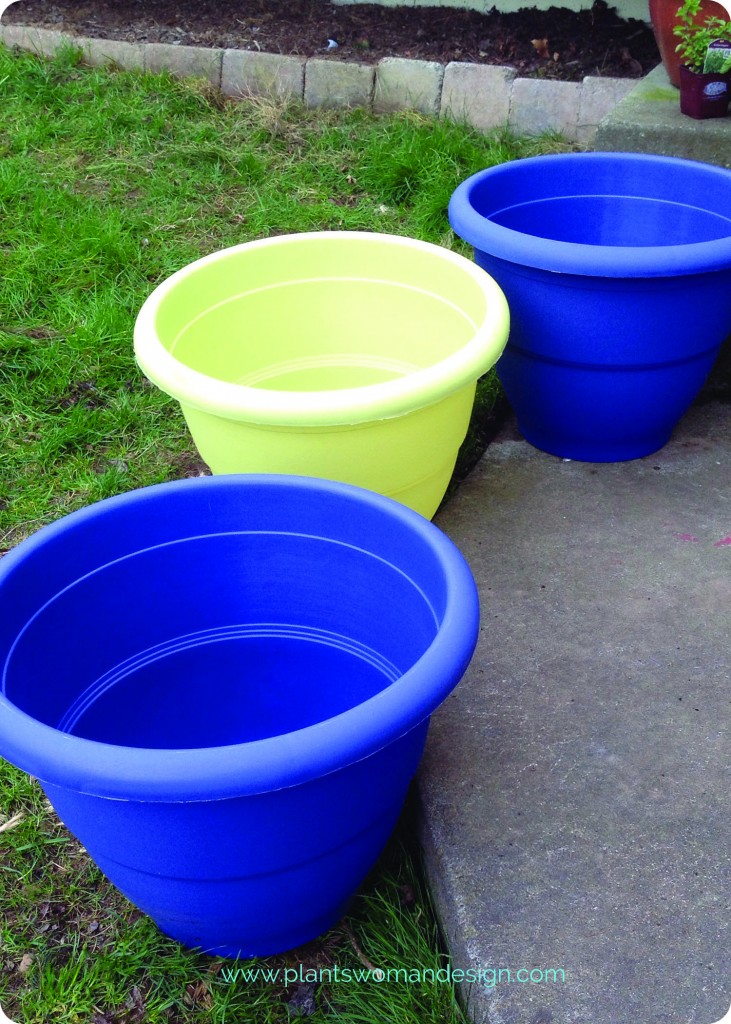
First we will need to provide drainage holes. These pots, purchased at Lowe’s, have ‘punch outs’ for the holes. Jen worked on punching out the holes with a screwdriver and hammer but ended up using a drill instead because the first container fractured instead of giving a nice clean hole. The integrity of the container is still there but it doesn’t look ‘perfect’ anymore.
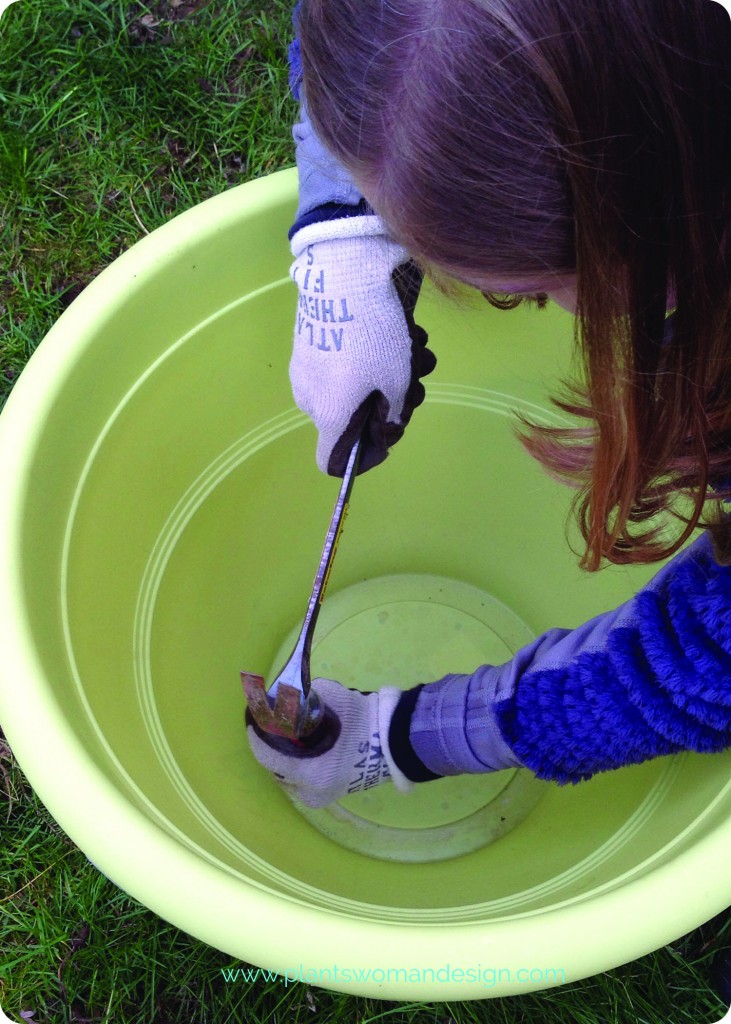
Next step is to add filler. We recommend choosing containers that are at least 2 1/2 feet tall by 2 1/2 feet across. Fill in enough space to leave 18 inches from the top. This pot will house herbs that can overwinter (stay out all winter with out dying) so they get a little more soil than containers that get to come inside for the winter. Adding filler allows the growing material to be easily reached, have just enough soil to grow plants successfully and aids in drainage. The root systems of most vegetables are about 6 inches to 1 foot down in regular garden beds, which is what our plants will get. Too much soil becomes waterlogged and can cause problems for the roots of your plants. Look for something light weight so the container can be moved easily if needed. Pebbles, rock and dirt are not a good choice. Packing pellets, plastic bottles with lids, or crushed 4 inch growers pots are good choices (and help you recycle). Keep in mind you want the water to drain past the filler material not get trapped in it. If your drainage holes are bigger than a dime go ahead and place a larger piece of broken clay pot or an upside down growers pot at the drain holes so they don’t get clogged.
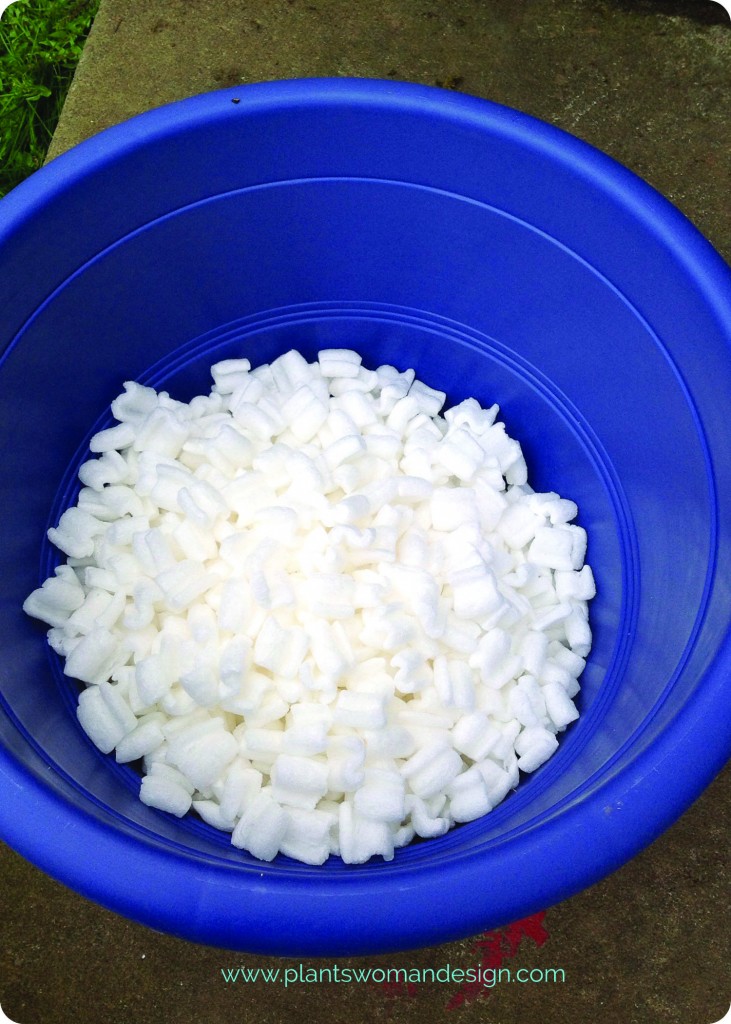
Next we need to add the soil and compost which we picked up at the local nursery. We chose an organic soil mix with no fertilizer in it and planting compost. I like to mix some extra nutrients into the potting soil using 1/3 planing compost and 2/3 potting soil mix.
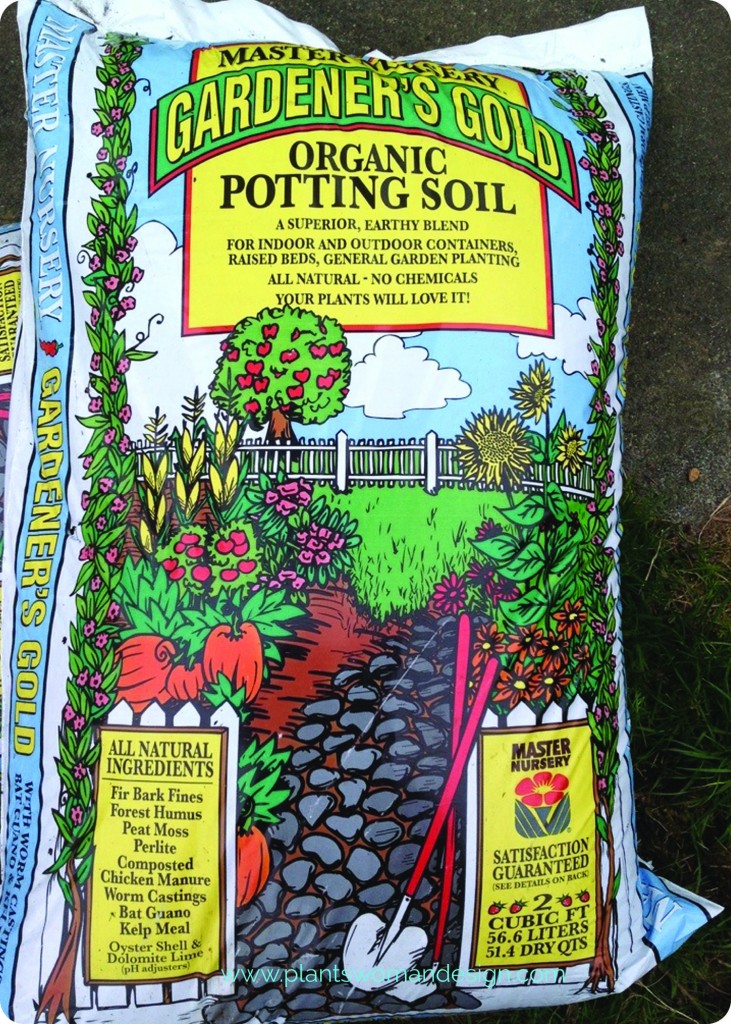

Pour in your soil and compost then mix the materials together by hand…. Mmm, smells good as we mix the soil and compost. We tapped the container a few times to settle the soil and filled it up to about 2 inches from the top
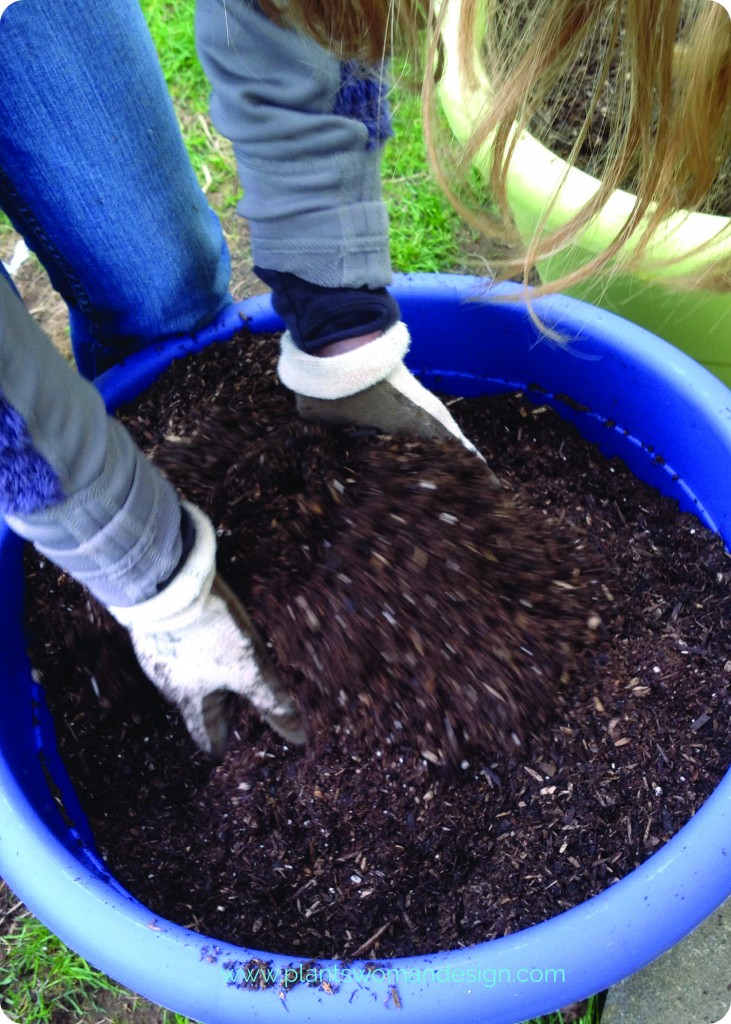
Now that your soil is ready it’s time to place our plants. In container planting I like to work with heights and textures when planning my container. Place all the herbs, still in their pots, into the container to come up with a pleasing arrangement. I like to put plants that are tall in the center and creepers towards the edge so they have somewhere to go as they grow (looks great and makes harvesting easier). Then arrange fat leaves next to small leaves and spiky in between. There is still a little room here for our basil seeds when it gets a little warmer. Be sure to keep them in order when you start planting so you can remember the arrangement.
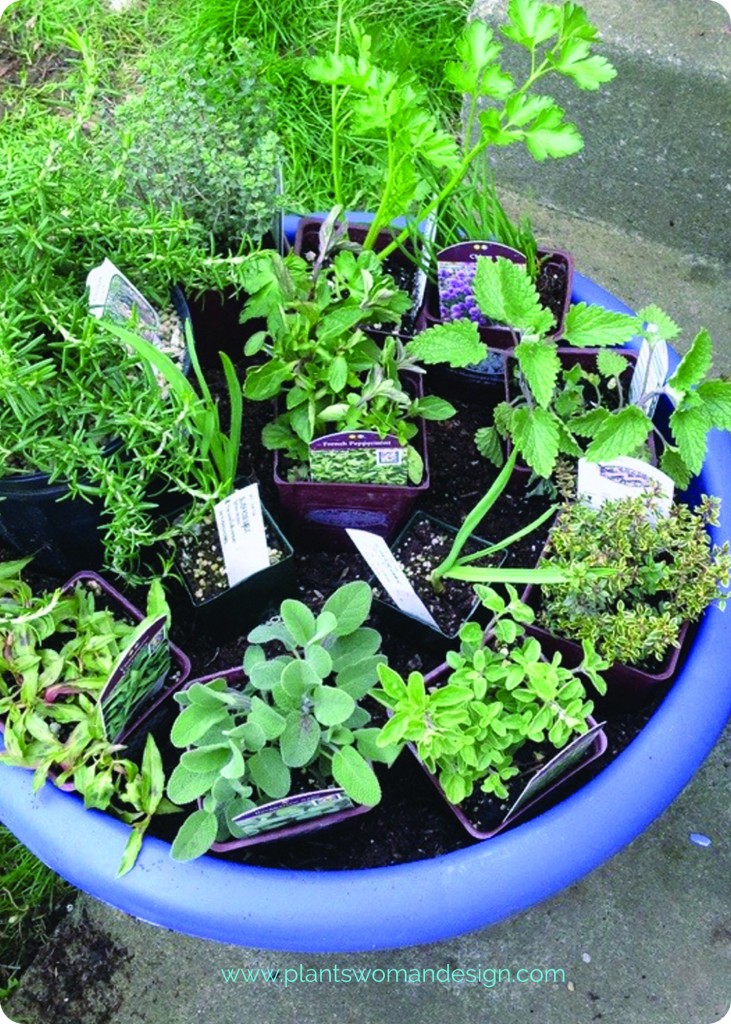
Now time to plant! Starting in the middle pull the plant out of the pot, gently tease the roots apart so they will start reaching out to the soil right away and plant it at the same soil height it had in the pot.
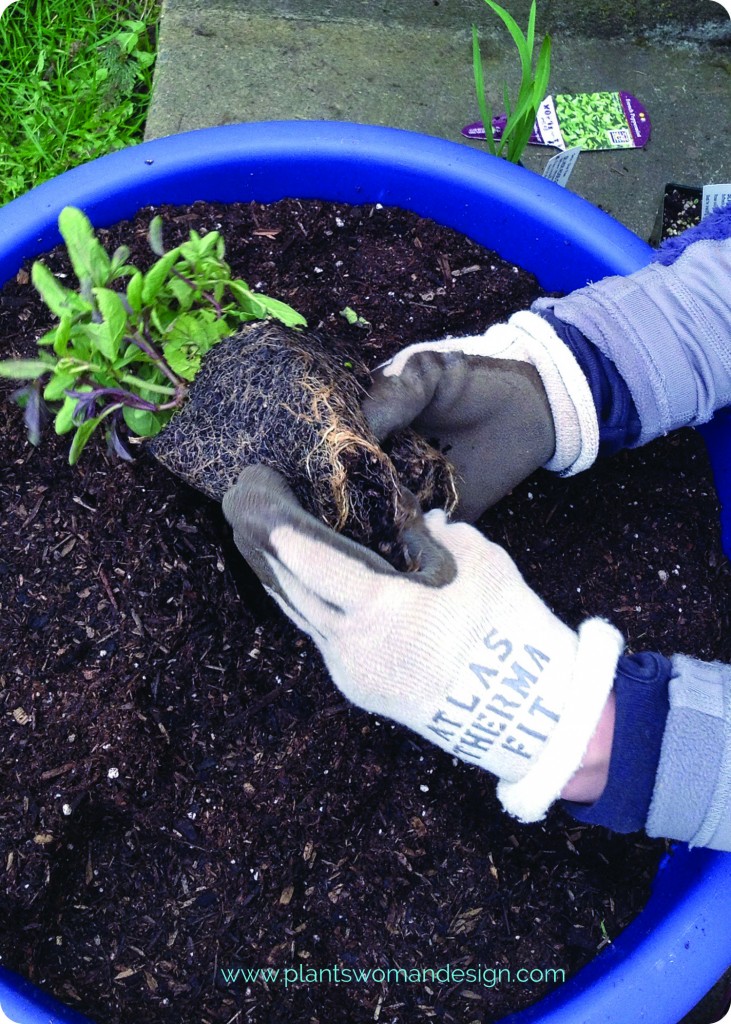
Gently firm down the soil before going planting the rest of the container in the same manner. This time of year the plants are not usually root bound (a tight network of roots from being in the pot too long). If they are you may have to get a little more aggressive with the ‘teasing of the roots’. Save all the tags and place them in the corner of the container in case you need to look at them.
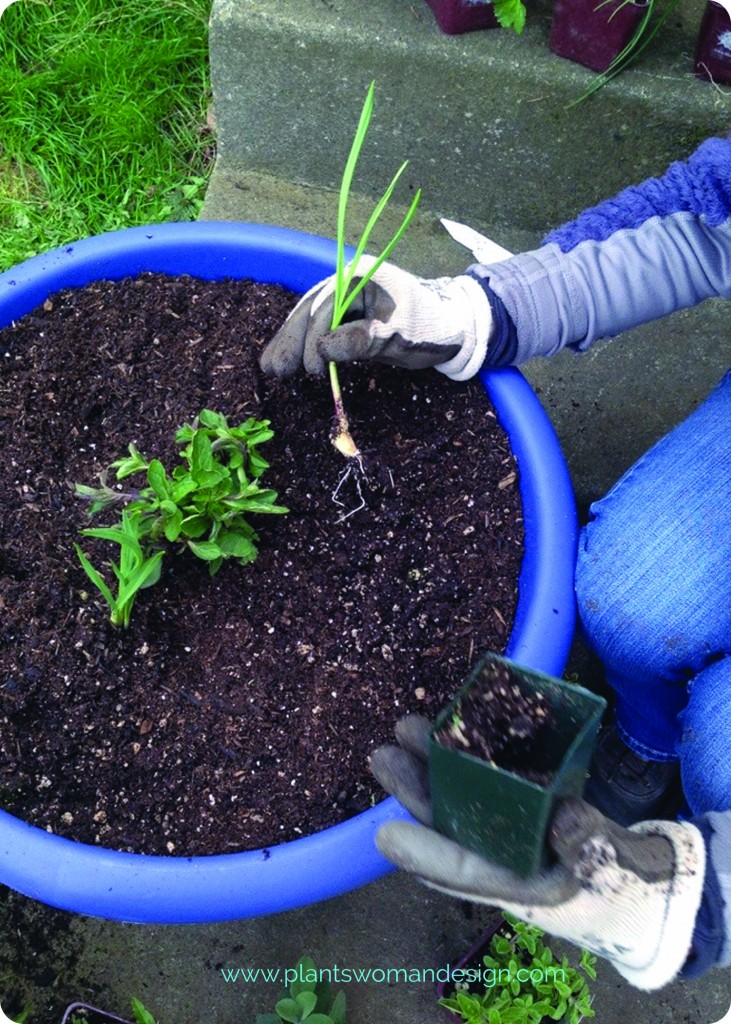
After all is planted it is time to soak the soil with water. Use a gentle spray of water until you see liquid running out of the bottom of the container. Check the plants to see that they are still firm in the soil (some may need to be re seated because of air pockets). Add a top coat of compost and you are finished! We will fertilize in a few weeks but I like to give the herbs a little time to adjust to their new home before fertilizing. For the most part herbs aren’t heavy feeders so we will only give them a little boost as they get started growing.
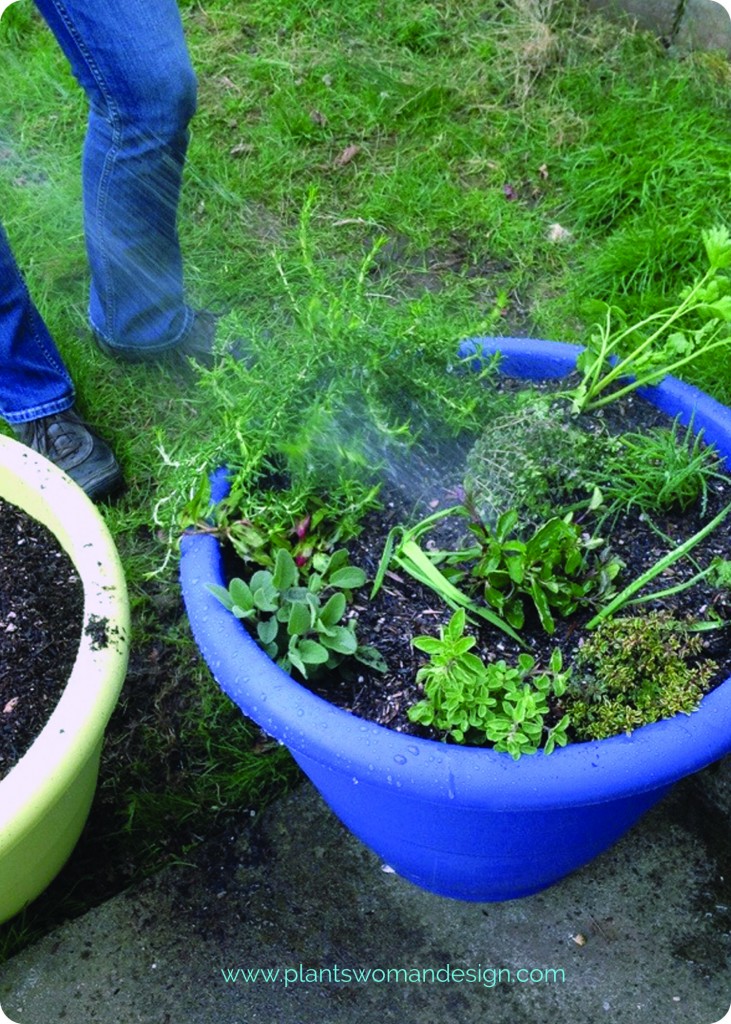 And we are done!
And we are done!
See below for the list of the herbs Jen used. Kristen has the same herbs in Chicago and will post about her potting experience next week. She is in zone 5 so her spring is several weeks away so her plants get to hang out inside for a bit.
It’s always more fun to learn and garden together so let us know if you are joining in with us! You can let us know by posting to our facebook page, sharing on twitter (@susan_PWD) or leaving a comment below.
We will have harvesting tips and recipes to follow. We can plant, grow, and enjoy the fruits of our labors (literally)!!
Keep growing, Susan
Plant List:
- Rosemary Irene
- Silver Rose Garlic
- Chives
- Lemon Catnip
- Sicilian Oregano
- Silver Variegated Lemon Thyme
- Flat Leaf Parsley
- French Peppermint
- Berggarten Sage
- Vietnamese Coriander
- Gold Variegated Lemon Thyme
by Kristen | Mar 21, 2014 | Little Bytes, Plantswoman Design
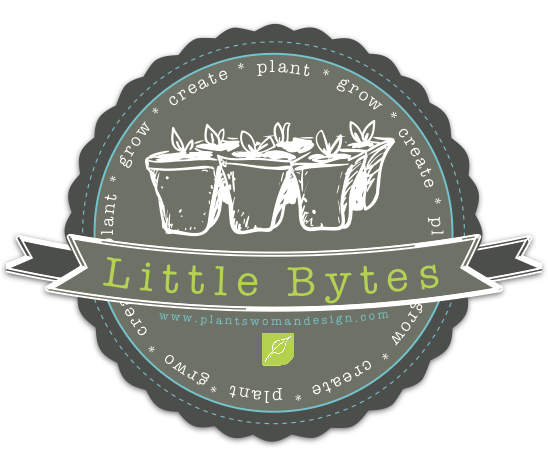
We are so excited to share with you about Little Bytes (you may have seen us mention it in our recent blog posts). We’ve noticed over the past year many folks saying “I wish I could grow something like that” and “If someone would break it down for me I think I could do that”. Well, we’ve heard you and we are on it. We will be spending the next year (and beyond) focusing some time on “breaking it down” for you, hence the name “Little Bytes”. Little pieces of information you can use in your garden right now!
In taking on this new project I needed some guinea pigs, I mean, “test gardeners”, and who better to work with than my very own daughters, Jennifer and Kristen! You may recognize them as they have helped me with the blog already but now we get to garden together.
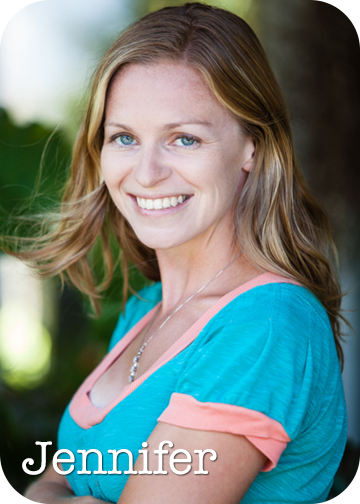
A little about Jennifer… She lives here in the Northwest with her husband and daughter, Kayla. She keeps my office humming and the crew on their feet. Jennifer has been dabbling in her garden for the last couple of years and is ready to take on new challenges. She’s agreed to be a test gardener for me and you can check out her profile on our “Meet the Gardener” section of the blog.

A little about Kristen… She lives in Chicago, Illinois with her husband and two kids, Emma and Finn (who have been on the blog before too). Though she is my daughter that doesn’t mean she’s an expert gardener. Actually she’s a beginner. She’s agreed to write about her beginning gardening experiences and share about them with you here on the blog. You can check out her profile on our “Meet the Gardener” section of the blog as well.
Our goal with Little Bytes is to grow gardeners. You don’t have to have any experience with gardening to be able to journey with us and grow something for the first time. We want to foster a community of people who are stepping out to start their garden journey along with seasoned gardeners of all types. So, what do you say, are you in with us?











































